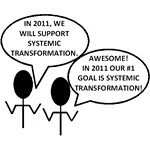In last week’s post I suggested that the sector might be strengthened if some ‘mission-failing’ organizations were to close. I defined mission-failing organizations as those that were not providing sufficient cultural or social value relative to the investments in them. It’s an awkward phrase and I find it difficult to describe a mission-failing organization with any confidence; however, I can give an example of its opposite–an organization that is providing great cultural and social value–and did so in a talk I gave in 2010 called The Excellence Barrier.
Here’s what I said (additional comments follow the excerpt):
Susan Sontag once wrote, “Existence is no more than the precarious attainment of relevance in an intensely mobile flux of past, present, and future.” I take particular note of the phrase, “precarious attainment of relevance.” No organization can be granted relevance in perpetuity based on the size of its endowment, the permanence of the building it occupies, the fact that it was the first or largest of its kind in its region or city, or its historic accomplishments. The institution exists to matter to people, in a particular community, today. That is the impact that must be assessed.
What does impact look like if not the metrics we’re currently assessing? Alan Brown has done terrific work in assessing intrinsic impacts and community engagement, and I couldn’t begin to summarize his research here—but I suggest you take a look at it.  I would, however, describe what I consider to be one of the best examples in the US of an organization that is brokering relationships between people and art.
In 2003, choreographer Elizabeth Streb opened a performance space in the Williamsburg neighborhood of Brooklyn, N.Y. called S.L.A.M. Instead of creating a church-like space that patrons visited once a week for a sacred experience, Streb opened the doors and let people come in anytime to watch rehearsal or use the restroom. She added popcorn and cotton candy machines and let people walk around and eat food during the performances.
Streb noticed that her patrons wanted to join in on the action, so she installed a trapeze and began teaching people how to fly. Performances largely feature the professional company, but Streb also features her students in the shows. Not content to simply use the platform of S.L.A.M. to promote her own work, Streb began fostering the development of the next generation of artists, through an Emerging Artists Commissioning Program.Â
Streb no longer needs to advertise her performances because she has created a robust social network that drives ticket sales. There is a palpable energy and familiarity in the room—people know each other and interact in the space as they would at a backyard barbecue. People come back to the performances time after time and the “initiated” (kids and adults alike) delight in showing newcomers the ropes, both literally and figuratively. The experience is participatory, not transactional.
Streb’s success is measured not when the ticket gets sold at the box office, but thirty minutes after the show when everyone is still lingering, buzzing, and talking with one another and the artists. Streb is cultivating “true fans”—a diverse group of people who are deeply engaged, enthusiastic, and loyal. As Kevin Kelly, author of the article, “1,000 True Fans” might say, Streb’s fans “buy the t-shirt, and the mug, and the hat.” Streb does not behave as if achieving artistic virtuosity and being relevant to the community are competing or mutually exclusive goals. She is pursuing excellence and equity.Â
By highlighting Elizabeth Streb I am, by no means, suggesting that the sector should institutionalize her particular approaches or practices. The key takeaway is this: You cannot miss Streb’s value when you go to S.L.A.M. And I would suggest that the opposite is also true. You know a walking dead organization when you see one.
An important point: in using the term ‘mission-failing’ I was intentionally avoiding the generic term ‘failing’ as I think it implies financial failure and one cannot assume that the groups that struggle the most financially are those that are providing the least value to society. (Though it is logical to ask how sustainable, and able to maximize mission, such financially failing organizations are and whether consolidation, strategic partnership, or merger with another organization might be necessary. Brian Newman has written a terrific post, Nonprofit Arts Zombies, on this topic.)
Pete Miller asked in his astute comment to last week’s post: “What is the path forward to winnow mission accomplishing organizations from time marking organizations?” Again, there is no easy answer. With very few barriers to entry (the IRS doles out 501c3 status like XTC at an 80s rave) growth of the sector will, no doubt, continue. It will, thus, become all the more imporant that we figure out how to ensure that resources are well utilized.
I do not believe it is the role of the NEA or any other funder in the US to hold ‘death panels’ and determine which organizations are mission-failing and should close. Ultimately, it seems that it is nonprofit boards and staffs that must wrestle with this question and charge themselves to take the decision that is in the best interest of the greater good.
In the meantime, funders need to determine what to do with their limited resources. As a philanthropoid friend wrote to me last week, “You spread the pain or you concentrate it. We all know we should target, but almost everyone just spreads the pain because it’s emotionally easier.” Candidly, we may not be able to (and I know many would argue we should not) reduce the actual number of nonprofit theaters (and other types of arts organizations) that exist; but funders certainly can reduce the number of organizations that receive grants and subsidies. Private and government funders should target their resources, and they should target them to those that are clicking on all cylinders, so to speak–and within that group, might I suggest prioritizing those organizations that cannot as easily cultivate support from individual donors or develop other revenue streams.
There were several posts last week at #supplydemand. I’ve put some of them in my featured texts section. If there are other relevant posts and texts you’d like to see included send them to me.
Two housekeeping matters: (1) Here’s a new essay, Rethinking Cultural Philanthropy, which I wrote for last week’s State of the Arts Conference in London; and (2) you can now follow me on Twitter at DERagsdale.
Image of Elizabeth Streb’s book STREB: How to Become an Extreme Action Hero.






